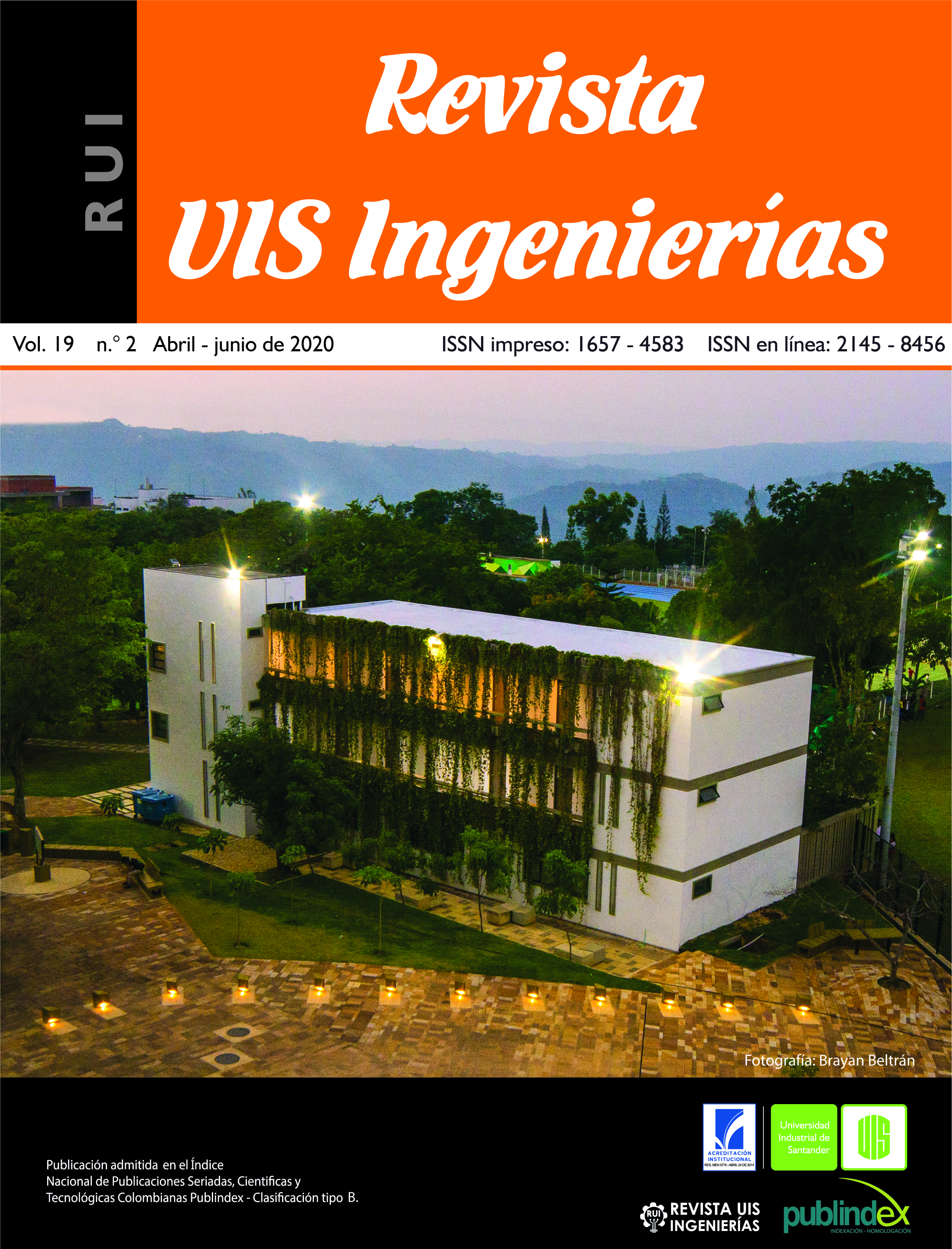Publicado 2020-03-09
Palabras clave
- tratamiento térmico,
- ondas electromagnéticas,
- calentamiento híbrido,
- materiales heterogéneos
Cómo citar
Derechos de autor 2020 Revista UIS Ingenierías

Esta obra está bajo una licencia internacional Creative Commons Atribución-SinDerivadas 4.0.
Resumen
En este artículo se presentan resultados de la simulación del tratamiento térmico híbrido de materiales, utilizando ondas electromagnéticas en el rango de las microondas y el calor por radiación térmica generado por una resistencia eléctrica. La resistencia se ubicó de tal forma que solo la mitad del sólido (una esfera de dos capas) recibe la energía generada por ésta. Además, la resistencia se controló de tal forma que generó energía térmica de forma uniforme y constante. Igualmente, se definieron materiales con propiedades termofísicas diferentes en cada capa, pero invariantes tanto con la posición como con la temperatura. El flujo de calor volumétrico se consideró constante con el tiempo. Los perfiles de temperatura para cada capa mostraron variaciones en el tiempo y la posición, observándose que el calentamiento simultáneo facilita la manipulación de estos perfiles, de acuerdo con las necesidades del tratamiento térmico. Así, se evidenció la ventaja de éste tipo de calentamiento híbrido.
Descargas
Referencias
[2] B. Yan et al., “Microwave treatment regulates the free volume of rice starch”, Sci. Rep., vol. 9, no. 1, pp. 3876, 2019, doi: 10.1038/s41598-019-40598-3
[3] J. A. Rudd et al., “Solvent-free microwave-assisted synthesis of tenorite nanoparticle-decorated multi-walled carbon nanotubes”, J. Mater. Sci. Technol., vol. 35, no. 6, pp. 1121–1127, Jun. 2019, doi: 10.1016/j.jmst.2019.01.002
[4] Y. Liu, T. Jiang, C. Liu, W. Huang, J. Wang, and X. Xue, “Effect of microwave pre-treatment on the magnetic properties of Ludwigite and its implications on magnetic separation”, Metall. Res. Technol., vol. 116, no. 1, pp. 107, Dec. 2019, doi: 10.1051/metal/2018087
[5] D. Jhodkar, M. Amarnath, H. Chelladurai, and J. Ramkumar, “Experimental Investigations to Study the Effects of Microwave Treatment Strategy on Tool Performance in Turning Operation”, J. Mater. Eng. Perform., vol. 27, no. 12, pp. 6374–6388, 2018, doi: 10.1007/s11665-018-3742-7
[6] Ł. Zedler, M. Klein, M. R. Saeb, X. Colom, J. Cañavate, and K. Formela, “Synergistic Effects of Bitumen Plasticization and Microwave Treatment on Short-Term Devulcanization of Ground Tire Rubber”, Polymers (Basel)., vol. 10, no. 11, pp. 1265, Nov. 2018, doi: 10.3390/polym10111265
[7] H. Xiao, L. Lin, and F. Fu, “Temperature characteristics of wood during microwave treatments”, J. For. Res., vol. 29, no. 6, pp. 1815–1820, Nov. 2018, doi: 10.1007/s11676-018-0599-4
[8] S. S. Behera, S. K. Panda, D. Mandal, and P. K. Parhi, “Ultrasound and Microwave assisted leaching of neodymium from waste magnet using organic solvent”, Hydrometallurgy, vol. 185, pp. 61–70, May 2019, doi: 10.1016/j.hydromet.2019.02.003
[9] Y. Kang et al., “Microwave-constructed honeycomb architectures of h-BN/rGO nano-hybrids for efficient microwave conversion”, Compos. Sci. Technol., vol. 174, pp. 184–193, Apr. 2019, doi: 10.1016/j.compscitech.2019.02.029
[10] G. G. Morbioli, N. C. Speller, M. E. Cato, T. P. Cantrell, and A. M. Stockton, “Rapid and low-cost development of microfluidic devices using wax printing and microwave treatment”, Sensors Actuators B Chem., vol. 284, pp. 650–656, Apr. 2019, doi: 10.1016/j.snb.2018.12.053
[11] A. Banerji, L. Ananthanarayan, and S. S. Lele, “Dough browning inhibition of multigrain Indian flatbread (chapatti) using a combination of chemical and microwave treatment”, J. Food Meas. Charact., vol. 13, no. 1, pp. 807–820, Mar. 2019, doi: 10.1007/s11694-018-9993-z
[12] A. B. Mahdi and C. Gomes, “Effects of microwave radiation on micro-organisms in selected materials from healthcare waste”, Int. J. Environ. Sci. Technol., vol. 16, no. 3, pp. 1277–1288, Mar. 2019, doi: 10.1007/s13762-018-1741-8
[13] J. Wang, T. Jiang, Y. Liu, and X. Xue, “Influence of microwave treatment on grinding and dissociation characteristics of vanadium titano-magnetite”, Int. J. Miner. Metall. Mater., vol. 26, no. 2, pp. 160–167, Feb. 2019, doi: 10.1007/s12613-019-1720-1
[14] M. Liu, C. Li, and Q. Wang, “Microstructural Characteristics of Larch Wood Treated by High-intensity Microwave”, Bioresour. Vol 14, No 1, 2018
[15] J. Liu, C. Zhang, S. Guo, L. Xu, S. Xiao, and Z. Shen, “Microwave treatment of pre-oxidized fibers for improving their structure and mechanical properties”, Ceram. Int., vol. 45, no. 1, pp. 1379–1384, Jan. 2019, doi: 10.1016/j.ceramint.2018.08.311
[16] S. Singh, P. K. Jain, and Rizwan-uddin, “Analytical Solution for Three-Dimensional, Unsteady Heat Conduction in a Multilayer Sphere”, J. Heat Transfer, vol. 138, no. 10, Oct. 2016, doi: 10.1115/1.4033536

